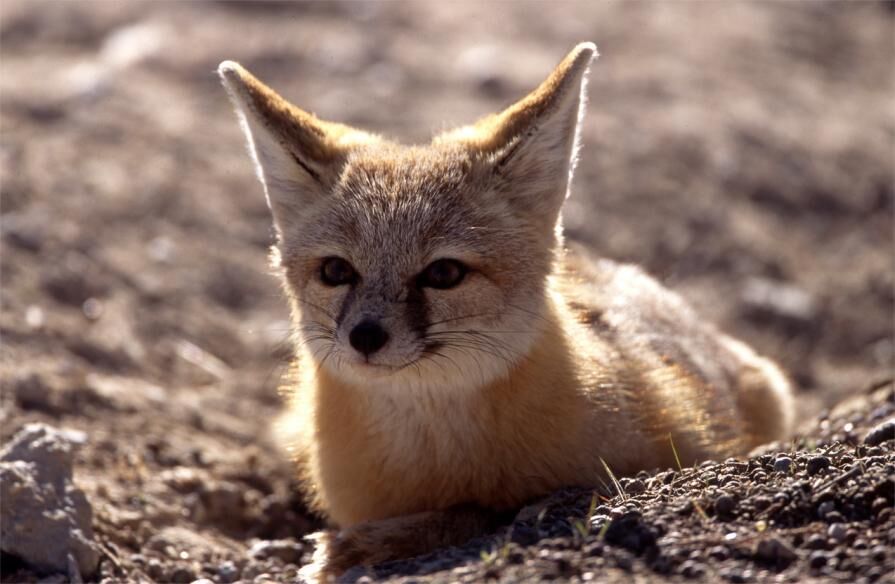Wildlife Conservation Biologist Scott Gibson boot-crunched across rocky desert soil a short distance from a dirt road buzzing with recreationists, scanning a series of sparsely vegetated washes for the unobtrusive wildlife camera he’d set up the week before. He had an exact location for the camera stored on a GPS unit, but was confident he could find it from memory.
“It may be behind that rock,” he mused, cresting a low ridge and looking down into the next wash.
He spotted it a few steps later. The camera was attached to a low post, pointed at a lure situated about a foot off the ground: a bouquet of cotton swabs doused with a scent specifically formulated to attract foxes. Biologists from the Utah Division of Wildlife Resources are using camera set-ups like these across the state to gather more information on kit foxes, a desert species that may be in decline.
“The intent of this is to try to get some good baseline data that we can use going forward for monitoring kit fox populations,” explained Gibson, who covers the southeast part of the state for the DWR.
“They’re tiny little guys,” said Gibson. “They’re only between three and five pounds; lengthwise, they’re about two and a half feet long and stand about a foot tall.”
The diminutive foxes have proportionally very large ears, a desert adaptation which helps them disperse heat. They dig burrows to live and raise their pups in, and feed on insects and small mammals such as rabbits and mice. They are able to fill their water needs using metabolic water; that is, water that comes from the food they eat. This capability allows
them to thrive in sparse, dry areas like the one where Gibson was checking his camera.
“Looks like something’s at least kind of tipped the lure,” he said, kneeling down to swap out the data card on the camera and noticing that the cotton swabs were askew.
Studies conducted by other entities, such as universities, suggest that kit fox populations are dropping, but the DWR has scant data on how many of the animals there are, and where they are, in the state. Information on kit fox distribution on the Colorado Plateau is particularly lacking.
To build up its knowledge of the species, the DWR began an “occupancy analysis” this year, using protocols developed by a graduate student at Brigham Young University. Researchers divided the state into 2.5 by 2.5 kilometer grids and evaluated those grids as possible monitoring sites based on factors like terrain and habitat. About 150 of those grids will be included in the study, conducted mostly by DWR biologists and technicians with help from the Bureau of Land Management and the National Park Service.
Each grid is equipped with a baited wildlife camera that’s checked weekly for images of kit foxes, which are generally active at night. Monitoring takes place during their breeding season, between January and May. During this time, the animals stay close to the burrow where they raise their pups, called a whelping den; monitoring in this season precludes the possibility of picking up a “dispersing juvenile” who is only passing through the grid, not using it as long term habitat. The DWR plans to repeat this protocol for the next several years to learn where kit foxes are and to observe trends in their population levels. That information will help the agency decide what, if any, management steps need to be taken.
The study is in line with the DWR’s Wildlife Action Plan, a 10-year management document developed “to help keep native Utah species off the Endangered Species List,” according to the DWR’s website. The current Wildlife Action Plan covers 2015-2025, and identifies kit foxes as one of 141 “species of greatest conservation need.” Species are evaluated based on criteria in three categories of consideration by the DWR: the likelihood that the species may be added to the federal endangered species list, the consequences of such a listing, and the agency’s ability to influence a listing decision. They’re also scored on a “threat assessment” that weighs potential impacts on a species from things like farming and ranching, drought, invasive species, fire, or development.
“A threat could be lack of data,” Gibson noted. Species of greatest concern are either in need of conservation or more data to understand their status, Gibson said, adding, “In the case of kit foxes, it’s probably a little bit of both.”
Experts aren’t sure what might be causing the apparent decline. Coyotes are a major predator for kit foxes, so an increase in coyote populations might be a contributor. Coyotes might gain an advantage over kit foxes when an artificial water source, like a wildlife “guzzler,” is installed, because it opens up habitat to coyotes that previously only the metabolic-water-capable kit foxes could use. Habitat loss to development, or habitat degradation from human use or invasive species, could also be contributors. Anything that affects a species’s prey will affect that species: Last year, Rabbit Hemorrhagic Disease, a deadly virus that affects wild rabbits and pikas, was documented in Utah. [See “Rabbits suffer disease outbreak,” Aug. 7, 2020 edition. -ed.]
“We have seen rabbit die-off,” said Gibson. “Because rabbits are one of their main prey sources, if we get a decline in rabbits, then that certainly could impact kit fox populations.”
Gibson brought the data card from the wildlife camera back to a laptop in his truck and scrolled through the images. Photos showed blue sky, clouds, snow, and darkness—finally an animal appeared in gray tones, investigating the scent lure at night. It was a fox, with a fluffy tail and pointed nose and ears.
“That’s a red fox,” Gibson said, noting its large size, relatively small ears, and dark-colored legs. That doesn’t necessarily mean there are no kit foxes in the grid; Gibson and wildlife technicians will keep monitoring the location.
Gathering data is the first step. Once more is known, the DWR will consider conservation actions. For example, installing artificial denning structures for kit foxes in areas where guzzlers are installed could help the foxes evade coyotes. However, any action could have unexpected ripple effects. Gibson said modern land management philosophy is shifting toward a bigger-picture perspective on conservation methods.
“The paradigm in the past has been more of a single species approach,” he said. Now, managers are considering the landscape as a whole system when trying to maintain ecosystems, habitat and species populations. Within that approach, though, it’s still important to have details on each aspect of a landscape, including the animals that live there. More data on kit foxes will add another piece to the puzzle of understanding the landscape and its health.




